Iran Press/ Iran news: The art of calligraphy is one of the most reputable and famous arts in Iran. The glorious art of calligraphy and its numerous decorations have always been praised across the world.
The importance of the art of calligraphy among Iranian arts is such that some arts seem to be imperfect, without decorative calligraphy. Iranians more than any other nation have used various calligraphy to enrich and beautify earthenware, metallic vessels and historic buildings.
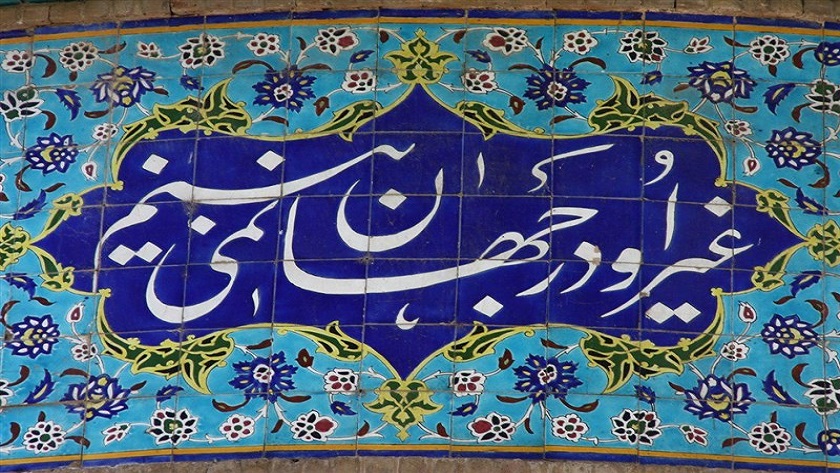 Calligraphy on tiles embellish Iranian architecture
Calligraphy on tiles embellish Iranian architecture
Indeed, Iranian calligraphy truly deserves such illuminations, and reverence that its masterpieces, when framed and set upon walls, bear all the attraction of great paintings, affecting even foreigners. Thus many of them are now lovingly collecting items of Iranian Calligraphy.
Related News: Int'l Silk Road Calligraphy Exhibition underway in Tehran
Cultural, Historical context
The history of Persian Calligraphy dates back to 500-600 BC during the first Persian empire, the Achaemenid dynasty when the original cuneiform scripts were used in monument inscriptions for the Achaemenid kings.
However, Calligraphy, the art of writing, is a distinctive feature of Iranian and Islamic civilization and its history goes back as far as the 7th century CE.
 Persian calligraphy is extensively used in decorating mosques
Persian calligraphy is extensively used in decorating mosques
Around roughly one thousand years ago, six genres of Iranian calligraphy (Tahqiq, Reyhan, Sols, Naskh, Toqi, and Reqa) were created. These genres were common for a few centuries in Persia. In the 12th century, the Naskh and Reqah styles were combined and a new genre of Persian calligraphy named Taliq (Taliq) was invented. Eventually, in the 14th century, Naskh and Taliq were combined, and the most attractive Persian calligraphy style, Nastaliq was created.
During the past 500 years, Nastaliq calligraphy has been one of if not the main Iranian script styles used in writing the Perso-Arabic script. Unlike its ancestors, Nastaliq flows effortlessly and is characterized by natural curves. In the 17th century, a new genre called cursive Nastaliq was created. This style is based on the same rules as Nastaliq, but it provides more flexible movement. It is more stretched and curved in comparison.
 Persian literature is also embellished by calligraphy and illumination
Persian literature is also embellished by calligraphy and illumination
The Safavid empire was an important period for art, including calligraphy, as many significant calligraphers appeared and many artistic works were produced during this time. It is the reign of Shah ‘Abbas, which has come to be considered the most productive period for these arts compared to his successors. The calligrapher Ahmad Neyrizi regularized and transformed the naskh script into a fine calligraphic style, which is still known as the Iranian style of this script and is used extensively for the copying of religious texts including the Quran. His style has since been used by other distinguished calligraphers such as Visal-i Shirāzi (Muhammad Shafi‘) during the Qajar period and to this day.

Safavid era Calligraphy in decoration of Chaharbagh Madraseh, Isfahan
Prominent styles
Kufic: Kufic as the earliest known calligraphic style, was the highest form of liturgical script and is therefore intimately associated with the transcription of the Qu’ran. Styles of calligraphy are often subdivided into two categories: rectilinear and curvilinear. Rectilinear scripts are angular with straight movements and rigid flat descending strokes below the line; curvilinear scripts are rounded and characterized by the curvature and softness of their strokes as you can see in the image below, Kufic in its earliest forms is clearly recognizable as a rectilinear script.
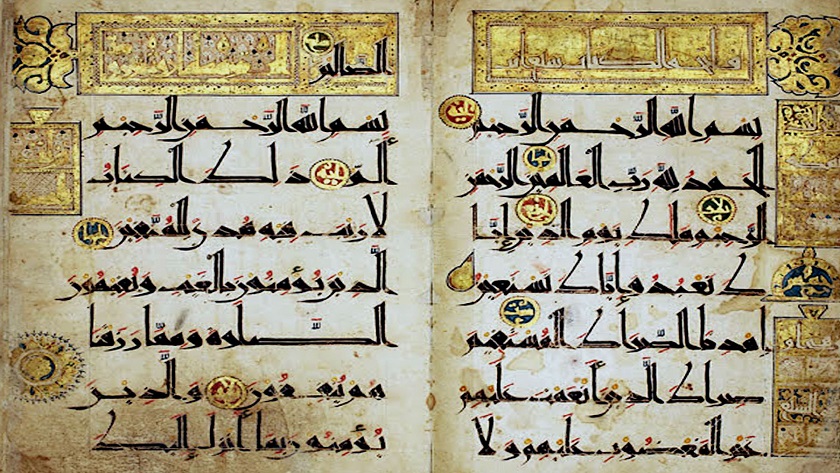 11th century Iranian Kufic script
11th century Iranian Kufic script
As Islam spread and took with it the Arabic script, however, we begin to see new more rounded styles of Kufic emerging with various names such as ‘New Style’, ‘Eastern Kufic’, ‘Persian/Iranian Kufic’, and ‘Western/Maghribi Kufic’ each according to the geographical boundaries of the Islamic lands in which the manuscripts were transcribed.
 A verse of Holy Quran written in eastern Kufic script, Iran, 11th-12th century
A verse of Holy Quran written in eastern Kufic script, Iran, 11th-12th century
Nastaliq: It is the most popular contemporary style among classical Persian calligraphy scripts. It is known as “Bride of the Calligraphy Scripts”. As a matter of fact, this calligraphy style has been based on such a strong structure that it has changed very little since that time. It is as if “Mir Ali Tabrizi” has found the optimum composition of the letters and graphical rules so it has just been fine-tuned during the past seven centuries.
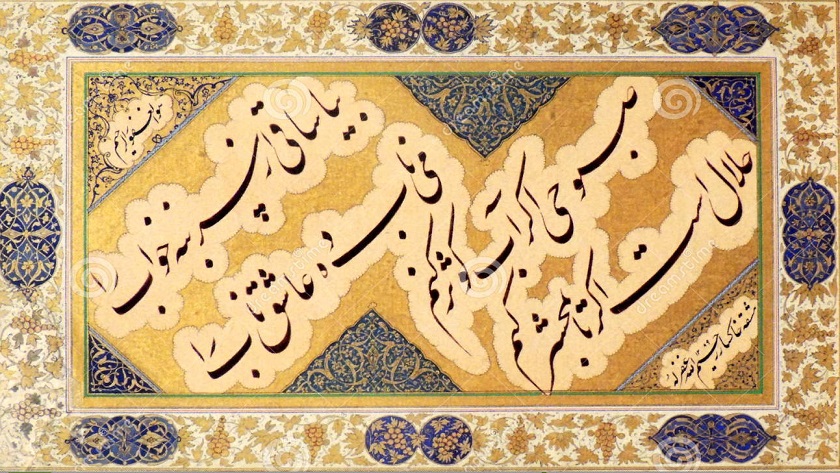 Persian calligraphy is world-famous with Nastaliq style
Persian calligraphy is world-famous with Nastaliq style
Nastaliq is the most beautiful Persian Calligraphy style and also technically the most complicated. It has strict rules for the graphical shape of the letters and for the combination of the letters, words, and composition of the whole calligraphy piece as a whole. Even the second popular Persian calligraphy style i.e. "Cursive Nastaliq" or "Shekasteh Nastaliq" noticeably follows the same rules as Nastaliq, with more flexibility of course.
Related News: Calligraphy expo in Mazandaran's Sari; manifestation of Iranian art
Religious, and cultural significance
In Islam, where the depiction of humans and animals is often avoided, the importance of calligraphy as a form of art was emphasized even further, and a great effort was put into the decoration and proportions of individual scripts to make them worthy of preserving the word of God. Calligraphy was used to decorate the walls and façades of buildings, as well as objects made in various media, such as coins, where it was the main, even the only, element of decoration.
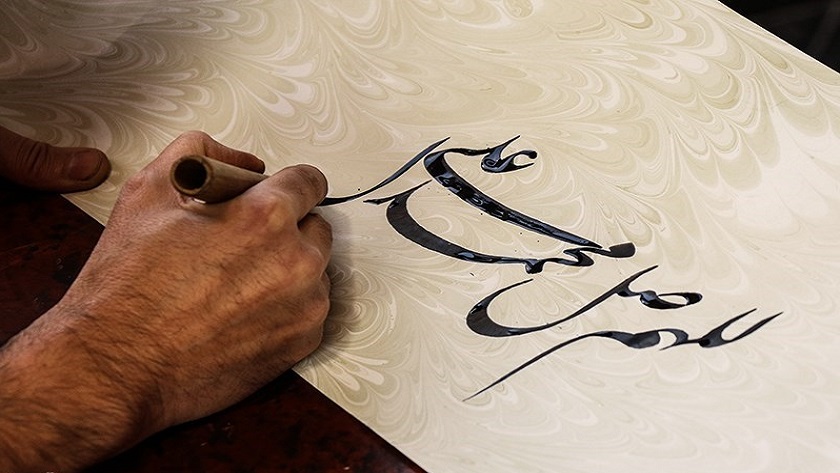 An artist inscribes peace be upon him Prophet Muhammad in Nastaliq
An artist inscribes peace be upon him Prophet Muhammad in Nastaliq
Over this long and geographically broad history many styles have flourished, each with their own contexts, rules and characteristics which have ultimately influenced the way people in Iran and across the Islamic world still write today. What follows is a brief overview of some of these styles and the figures associated with them, especially those associated with Persian.
Most of the handwritten books of Iran specially the Holy Quran, and collections of poems such as Shahnameh, Hafez, Golestan, Boostan and Khayyam have been recognized as precious artistic works because of their graceful and delicate calligraphy.
Related News: The Great exhibition of Holy Quran & calligraphy held in Birjand
 A piece of art by Mir Emad
A piece of art by Mir Emad
Renowned figures
Mir Emad (1556-1615) was one of the most famous Iranian calligraphers. Nostalgic calligraphy reached its zenith through wonderful works by Mir Emad.
Mir ‘Ali Heravi (1476-1544), who penned many quatrain pieces and manuscripts, and designed architectural inscriptions.
Ali Reza Abbasi (1565-1634) is one of the most important calligraphers of the Safavid Period. He was born in the central city of Kashan.
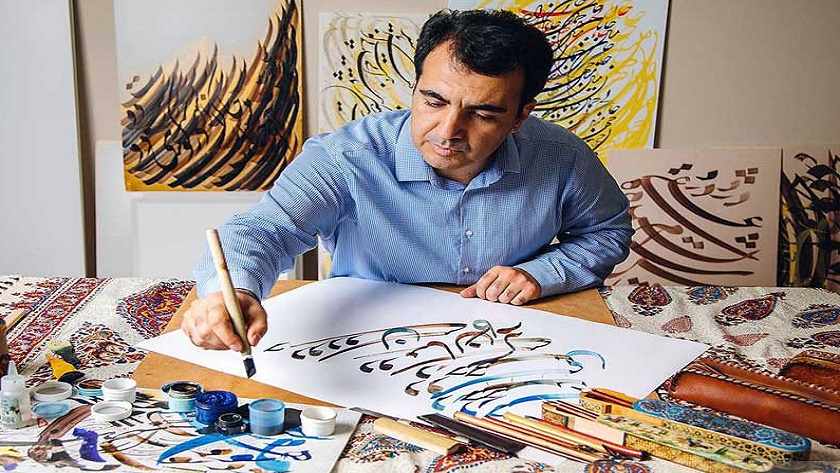 An Iranian artist practicing fine art of calligraphy
An Iranian artist practicing fine art of calligraphy
Calligraphy artistic legacy
Persian calligraphy art as a method in modern painting and contemporary Calligraphy, which was gradually flourished in the 1330s-1340s (Iranian year) with the efforts of some Iranian calligraphers and painters; so far, it has continued its life in contemporary art and has found followers in many regional countries.
Traditionally in Iranian books, the kitabi (book) style was used, itself inspired by naskh scripts. However, in recent years the hanging script of nasta‘liq has begun to replace it in student textbooks and accordingly these days people are more familiar with this script.
Related News: Video mapping of calligraphy on 'Azadi Tower' performed in Tehran
 Iranian people greatly respect grand art of calligraphy
Iranian people greatly respect grand art of calligraphy
A prominent contemporary Iranian artist, Kambiz Abdolzadeh, says the Persian calligraphy art has countless fans from other countries, especially European ones, who come to Iran every year to see and buy these works.
Iranian fine art of calligraphy is exhibited in Mir-Emad Museum of Sa’dabad Complex. This grand museum displays works of calligraphy covering a period of about 10 centuries. The first floor publicly displays works of art dating back to the pre-Islamic era, as well as Islamic writings, and handwritten manuscripts.
Read More:
Tehran's weekend: Mir-Emad Calligraphy Museum
Persian calligraphy art has brilliant place among Europe
Ashkan Salehian

